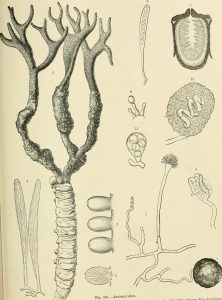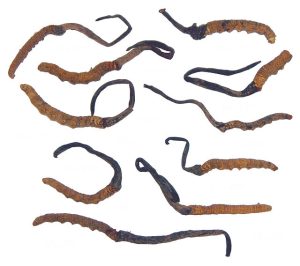HEALTH TOPICS
Spotlight on Cordyceps
Posted by: Jacob Byrne BHSc Adv.Dip Nut Med
For more than 2000 years, the parasitic fungus Cordyceps militaris (Cordyceps) has been utilised in traditional Chinese medicine (TCM) as a medicinal mushroom. It belongs to the Clavicipitaceae family and is one of the biggest and most diversified species in the fungus world, with about 500 different species. In recent years, the cultivation of the parasitic fungus has increased in both output and efficiency by infecting caterpillar lava, Hepialus armoricanus Oberthur (Lepidoptera), and cultivating the growth of the fungus at low altitudes. Cordyceps is naturally found at high altitudes on the Himalayan plateau growing on infected host insects. To provide a steady supply, the fungus is now grown commercially, and the procedure uses caterpillar lava or is produced through the use of tissue culture.
 In the past, Cordyceps was prescribed as a traditional medicine for a number of conditions, such as respiratory problems, exhaustion, and renal issues. It was also known to increase libido and enhance physical performance. The Chinese term for cordyceps is “Dong Chong Xia Cao,” which translates to “winter worm, summer grass.” This is because the fungus, which in the wild grows on caterpillar larvae (Lepidoptera), is parasitic. In the past, humans could only access cordyceps fungi on a small scale by gathering them from the wild and cultivating them in their natural habitat was near impossible since they require an insect host to survive. As a result, cordyceps was a rarer commodity in TCM and was highly valued for its capacity to increase libido and stamina, earning the name ‘Himalayan Viagra’ in modern times.
In the past, Cordyceps was prescribed as a traditional medicine for a number of conditions, such as respiratory problems, exhaustion, and renal issues. It was also known to increase libido and enhance physical performance. The Chinese term for cordyceps is “Dong Chong Xia Cao,” which translates to “winter worm, summer grass.” This is because the fungus, which in the wild grows on caterpillar larvae (Lepidoptera), is parasitic. In the past, humans could only access cordyceps fungi on a small scale by gathering them from the wild and cultivating them in their natural habitat was near impossible since they require an insect host to survive. As a result, cordyceps was a rarer commodity in TCM and was highly valued for its capacity to increase libido and stamina, earning the name ‘Himalayan Viagra’ in modern times.
 The Cordyceps fungi’s various active ingredients are a part of what makes it a potent nutraceutical. The Nucleoside analogue cordycepin possesses strong antiviral and anticancer effects. The polysaccharides in cordyceps support immune system regulation, accelerate wound healing and strengthen the body’s antioxidant defences. Adenosine, which helps to control blood pressure and enhance blood flow, is also present in fungi. These active components allow the fungus to take control of the host and start its reproductive lifecycle inside the host body by weakening the immunological defences of the host insects.
The Cordyceps fungi’s various active ingredients are a part of what makes it a potent nutraceutical. The Nucleoside analogue cordycepin possesses strong antiviral and anticancer effects. The polysaccharides in cordyceps support immune system regulation, accelerate wound healing and strengthen the body’s antioxidant defences. Adenosine, which helps to control blood pressure and enhance blood flow, is also present in fungi. These active components allow the fungus to take control of the host and start its reproductive lifecycle inside the host body by weakening the immunological defences of the host insects.
Nourishing foods are the best medicine, and cordyceps has an abundant amount of bioactive components such as proteins, fats, essential amino acids, volatile oils, carotenoids, phenolic compounds, flavonoids, minerals (Fe, Ca, Mg, Ni, Sr, Na, Ti, Pi, Se, Mn, Zn, Al, Si, K, Cr, Ga, V), vitamins (B1, B2, B12, E and K) as well as various types carbohydrates like monosaccharides, oligosaccharides, polysaccharides, sterols and nucleosides. When combined with its other active constituents, such as Cordycepin, cordyceps becomes a strong nutraceutical and therapeutic medicine.
Modern life, high-stress lifestyles and poor nutrition are prominent throughout all nations in the developed world, leading to lifestyle and dietary-related diseases. The benefits of using nutraceutical and ‘bioactive’ foods in the prevention of these conditions in gaining traction throughout the world, with many people turning to ‘superfoods”, medicinal mushrooms and other nutraceutical foods to fill this need and attain the best in preventive care and nutrient support through their diet and lifestyle choices. The presence of antioxidants acquired from including medicinal mushrooms in the diet could play an important role in the prevention of disease.
 Many health advantages can be obtained from taking cordyceps supplements. It has been discovered that boosting oxygen intake and boosting endurance, can improve athletic performance. Cordyceps helps to enhance cognitive performance, increase sleep quality, and lessen fatigue and stress. It can help with the management of diabetes by lowering blood sugar levels and enhancing insulin sensitivity. Moreover, it has been demonstrated to reduce cholesterol and improve kidney function. Research shows beneficial effects on numerous common ailments, such as diabetes, cardiovascular disease, osteoporosis, arthritis, and anti-malarial effects, in addition to being an exceptional antioxidant and immunomodulator, are shown to have therapeutic potential.
Many health advantages can be obtained from taking cordyceps supplements. It has been discovered that boosting oxygen intake and boosting endurance, can improve athletic performance. Cordyceps helps to enhance cognitive performance, increase sleep quality, and lessen fatigue and stress. It can help with the management of diabetes by lowering blood sugar levels and enhancing insulin sensitivity. Moreover, it has been demonstrated to reduce cholesterol and improve kidney function. Research shows beneficial effects on numerous common ailments, such as diabetes, cardiovascular disease, osteoporosis, arthritis, and anti-malarial effects, in addition to being an exceptional antioxidant and immunomodulator, are shown to have therapeutic potential.
In conclusion, Cordyceps is a fascinating fungus that has a variety of biochemical compounds that are shown to have a number of health-boosting advantages. It has long been a staple of traditional Chinese therapies, and it is now becoming more well-known as a medicinal mushroom supplement. Cordyceps shows promising benefits for conditions such as blood sugar management, immune system improvement, and greater athletic performance. This unusual fungus grows on host insects in a unique way when compared to other species of mushrooms, which makes it a truly exceptional and remarkable member of the fungi kingdom.
References
Ashraf, S. A., Elkhalifa, A. E. O., Siddiqui, A. J., Patel, M., Awadelkareem, A. M., Snoussi, M., Ashraf, M. S., Adnan, M., & Hadi, S. (2020). Cordycepin for Health and Wellbeing: A Potent Bioactive Metabolite of an Entomopathogenic Medicinal Fungus Cordyceps with Its Nutraceutical and Therapeutic Potential. Molecules, 25(12), 2735. https://doi.org/10.3390/molecules25122735
Das, S. K., Masuda, M., Sakurai, A., & Sakakibara, M. (2010). Medicinal uses of the mushroom Cordyceps militaris: Current state and prospects. Fitoterapia, 81(8), 961–968. https://doi.org/10.1016/j.fitote.2010.07.010
Jung, S.-J., Jung, E.-S., Choi, E.-K., Sin, H.-S., Ha, K.-C., & Chae, S.-W. (2019). Immunomodulatory effects of a mycelium extract of Cordyceps (Paecilomyces hepiali; CBG-CS-2): A randomized and double-blind clinical trial. BMC Complementary and Alternative Medicine, 19(1), 77. https://doi.org/10.1186/s12906-019-2483-y
Liu, G., Han, R., & Cao, L. (2019). Artificial Cultivation of the Chinese Cordyceps From Injected Ghost Moth Larvae. Environmental Entomology, 48(5), 1088–1094. https://doi.org/10.1093/ee/nvz099
Olatunji, O. J., Tang, J., Tola, A., Auberon, F., Oluwaniyi, O., & Ouyang, Z. (2018). The genus Cordyceps: An extensive review of its traditional uses, phytochemistry and pharmacology. Fitoterapia, 129, 293–316. https://doi.org/10.1016/j.fitote.2018.05.010
Raethong, N., Wang, H., Nielsen, J., & Vongsangnak, W. (2020). Optimizing cultivation of Cordyceps militaris for fast growth and cordycepin overproduction using rational design of synthetic media. Computational and Structural Biotechnology Journal, 18, 1–8. https://doi.org/10.1016/j.csbj.2019.11.003
Shyamal, L. (2008). English: Ophiocordyceps sinensis on caterpillars (Hepialidae: Thitarodes sp.) from collection of Womens collective, Munsiyari. Own work. https://commons.wikimedia.org/wiki/File:CordycepsSinensis.jpg
Wikipedia, T. original uploader was R. I. at E. (2007). English: Cordyceps sinensis choice specimens, mostly whole. Transferred from en.wikipedia to Commons by Lvova using CommonsHelper. https://commons.wikimedia.org/wiki/File:Cordyceps_Sinensis.jpg
Wu, F.-C., Chen, Y.-L., Chang, S.-M., & Shih, I.-L. (2013). Cultivation of medicinal caterpillar fungus, Cordyceps militaris (Ascomycetes), and production of cordycepin using the spent medium from levan fermentation. International Journal of Medicinal Mushrooms, 15(4), 393–405. https://doi.org/10.1615/intjmedmushr.v15.i4.70
Subscribe to Gr8Health
Sign up to get 5% off your first order, exclusive access to our special offers, new arrivals and more.